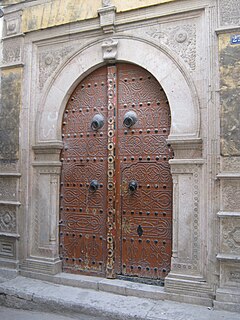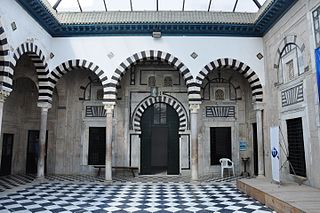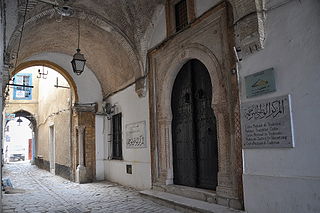
Dar Zarrouk is one of the palaces of the old town of Tunis. It is one of the largest historical palaces in Tunis.

Dar Zarrouk is one of the palaces of the old town of Tunis. It is one of the largest historical palaces in Tunis.
The palace is located on the street of Judges near the palace of Khurasanid dynasty's princes.
Dar Zarrouk is an aristocratic house that belongs to the Zarrouk family, we can mention for example Abou Abdallah Mohamed Larbi Zarrouk, a minister under the reign of Hammuda ibn Ali.
The palace was constructed by a privateer and Dey Murad during the seventeenth century, [1] and it was modified by the Zarrouk family during the eighteenth century.
It is composed mainly of a ground floor, the new owners added another house for their guests and a room to rest on the terraces. We can also find other outbuildings in the palace, such as a Grain Mill, a space to pray, and an inner garden. [2]
Mohamed Zarrouk, son of the minister Mohamed Larbi Zarrouk built three more apartments during the nineteenth century.

Mohammed Bey or M'hamed Bey was the eleventh Husainid Bey of Tunis, ruling from 1855 until his death. He was the son of Al-Husayn II ibn Mahmud and his second wife Lalla Fatima al-Munastiri.
Dar Djellouli is an old palace of the medina of Tunis. It is located in the Street of the Rich in Bab Jedid, near Tourbet el Bey.

Dar Bayram is an old palace located in the Andalusians Street, in the medina of Tunis. It is indexed as one of the biggest historical residences of Tunis, in the inventory of Jacques Revault, member of the Middle East and Mediterranean Studies Research Group.

Dar Ben Ayed is an old palace of the medina of Tunis. It is located in the Ben Ayed Street in Bab Jedid, near Tourbet el Bey and Souk Es Sabbaghine.

Dar Balma is an old palace in the medina of Tunis.

Dar Al Jaziri is a palace in the medina of Tunis. Located in the Tribunal Street, a few meters from Dar Lasram, it was one of the residences of the Jaziri family between the 12th and 18th centuries.

Dar Ibn Abi Dhiaf is a palace in the medina of Tunis, located near the Pasha Street and Sidi Mahrez Mosque, in the Ibn Abi Diaf dead end.

Dar Bach Hamba is an old palace in the medina of Tunis.

Dar El Haddad is one of the oldest palaces in the medina of Tunis.

Dar Bou Hachem is a palace in the medina of Tunis.

Dar Belhouane is a palace in the medina of Tunis, located at 64 Sidi Ben Arous Street. Today, it operates as a guest house.

Dar Caïd Nessim Samama is one of the palaces of the medina of Tunis.

Dar Daouletli is an old palace in the medina of Tunis.

Dar El Monastiri is a palace in the Medina of Tunis.

Dar El Cherif is an old palace in the Medina of Tunis. It is located in Sidi Maaouia Street, near El Monastiri and Achour Streets.

Dar Aziza is a 16th-century Moorish palace located in the Casbah of Algiers, Algeria. Today, it houses the National Agency of Archaeology and Protection of Historic Sites and Monuments.

Dar Adiyel or Dar 'Adiyil is a historic mansion in Fes el-Bali, the old medina of Fes, Morocco. It is located in the Zqaq el-Bghal neighbourhood, a short distance south from Tala'a Seghira street.

Dar Moqri is a historic palace or group of mansions in Fes el-Bali, the old medina of Fes, Morocco. It dates from the late 19th and early 20th centuries and was built by the wealthy and powerful Moqri family. The site is occupied by two grand residences built separately by members of the same family but physically adjoining each other. The older palace was begun by Abdelsalam al-Moqri and probably further modified by his son Muhammad. In addition to its rich interior, it is notable for its large terraced garden. The second palace belonged to his grandson Si Tayb and is notable for its long courtyard which mixes Italianate details with traditional Moroccan decoration. A completely separate palace, known as Riad Driss Moqri, was also built further north by Abdelsalam's son, Si Dris.
Youssef Saheb Ettabaâ, , was a Mameluk of Moldavian origin who became a principal minister of the regency of Tunis.
Mohamed El Aziz Ben Achour is a Tunisian politician and historian born on 5 January 1951; he specializes in urban, social and cultural history of modern Tunisia and the Islamic civilization. He was the Minister of Culture some time between 2004 and 2008, and later Director-General of the Arab League Educational, Cultural and Scientific Organization (ALECSO) some time between 2009 and 2013.